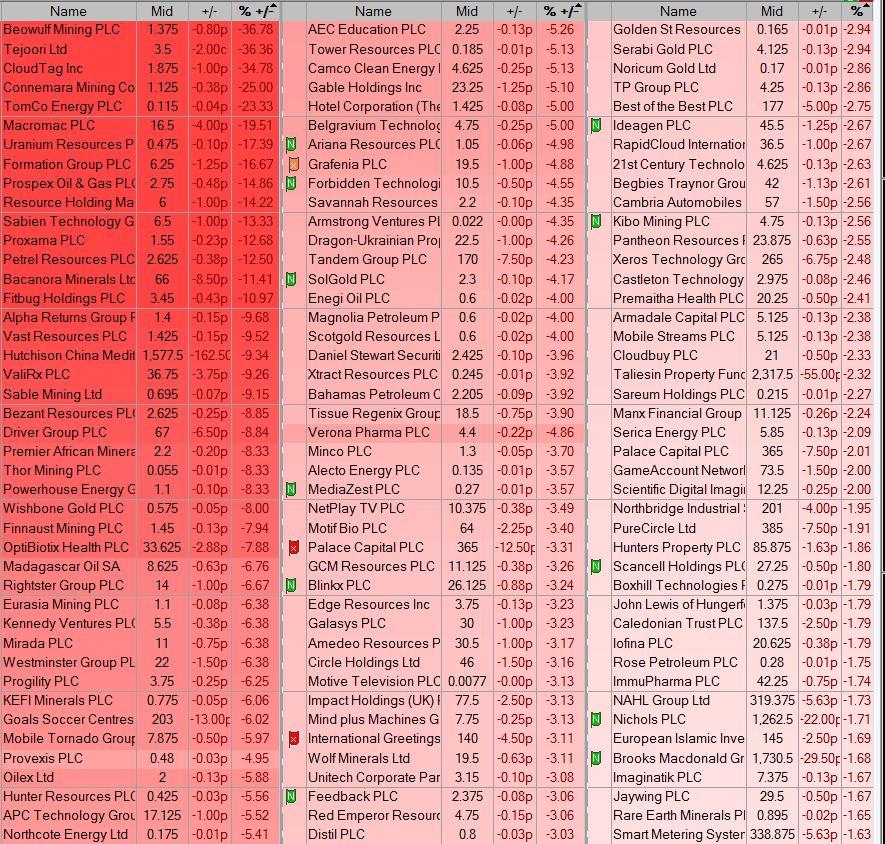Not all of you reading this will have lost money trading AIM (Alternative Investment Market) stocks, but many of you will.
Even those that are profitable are likely to have a selection of AIM shares suffering heavy losses.
Countless will be welcomed with a sea of red each time they log into their dealing accounts.
This may be why.
Ten year performance:
| FTSE 100 | 24.05% |
| FTSE 250 | 127.00% |
| DAX 30 | 133.70% |
| S&P 500 | 68.88% |
| Dow Jones | 67.62% |
| Nikkei 225 | 70.65% |
| AIM All Share | -26.25% |
| AIM 100 | -35.40% |
The numbers are very difficult to argue against.
Over the last ten years, the London AIM market has tremendously underperformed all major equity benchmark indices.
In the face of deflation, constraining demographics and natural disasters, even the Japanese Nikkei has managed to post gains.
That is not to say that all companies listed on the AIM market are basket cases, far from it. In fact, some of the best performing mutual funds focus on the AIM market.
Wood Street Microcap Investment Fund, which invests almost exclusively in AIM stocks, is up 185% over 5 years. However, the fund’s net assets are only £28.4m (31/12/14), which is dwarfed by funds that focus on Blue Chips such as Invesco Perpetual High Income (£13.2 billion) and Newton Global income (£4.54 billion).
Due to the lack of capital allocation from large fund managers, the Alternative Investment Market is dominated by inexperienced private investors who have limited capital and tend to gamble large percentages of their savings in single potential ‘multibagger’ shares touted on bulletin boards.
The participants and companies that make up the AIM have created a market that perplexes investors with baffling and unexplained price movements but keeps them coming back with the hope of getting rich quick.
Stock Spikes
A company has just had a brilliant RNS release, the long awaited approval or contract is finally here, the share price rallies sharply – only to just as quickly tumble back down.
These spikes occur all too often to companies listed on London’s AIM market. Similar to ‘pump and dump’ scams, these spikes draw unsuspecting investors in to sharply rallying stocks, that swiftly reverse, leaving many with loss making positions.
Very rarely do you see such pronounced chart patterns in FTSE 350 companies, typically strong results lead to analyst re-ratings and a continual trend higher. Of course there are bouts of profit taking along the way but these tend to be mere blips.
Extended Downtrends
One explanation for the peculiar price action in AIM stocks is that investors, who have long been sitting in losing positions, rush for the exit on the first sign of any positivity pushing prices back down.
As many stocks have been stuck is such long term downtrends, a positive update is seen by the overwhelming majority as an opportunity to cut their losses.
It’s the classic ‘I’ll get out on the next rally’.
The problem is, if everyone has the same plan a downside bias is created.
Lack of Liquidity
Exacerbating this phenomena is the lack of new funds disillusioned investors are willing to pump into offside positions they have been tied into for the last 18 months.
This lack of liquidity itself is to the detriment of many AIM stocks.
AIM stocks do not enjoy the level of coverage from investment banks that main market shares do. This means that there is a void of fresh buyers to invest on the back of a note from their broker that would provide beaten up main market stocks with some buyers.
The lack of buyers creates a situation where prices drift as investors throw in the towel, fed up with continual declines in share prices.
This only discourages other investors, creating a sluggishly slow snowball effect.
The Figures
Of the 1076 AIM listed stocks researched by the UK Investor Magazine, from a year ago, 364 are up, 634 are down and 78 are unchanged. Companies that are recorded as unchanged are either unchanged, suspended or have listed in the last year.
So of those covered, only 33.8% are up over a year against 58.9% that are down.
There is a valid argument that the AIM is a stock pickers market, indeed there are 48 companies that are up over 100% in the last year whereas only 3 stocks in the FTSE 350 have doubled.
Although there are 48 companies that have doubled, there are a whopping 225 stocks that have sunk more than 50%. That’s 20.9% of the total market.
For those that value statistics and probabilities when making investment decisions, the Alternative Investment Market will look utterly uninvestable.
That’s not to say you can’t make money from the AIM, take AB Dynamics is up 34% over the last year and Hutchinson China Meditech up 85.6% over the same period.




